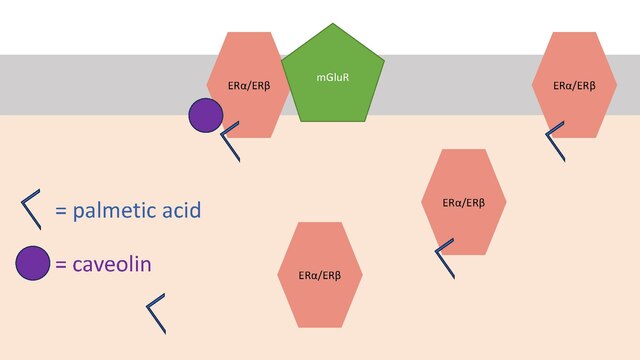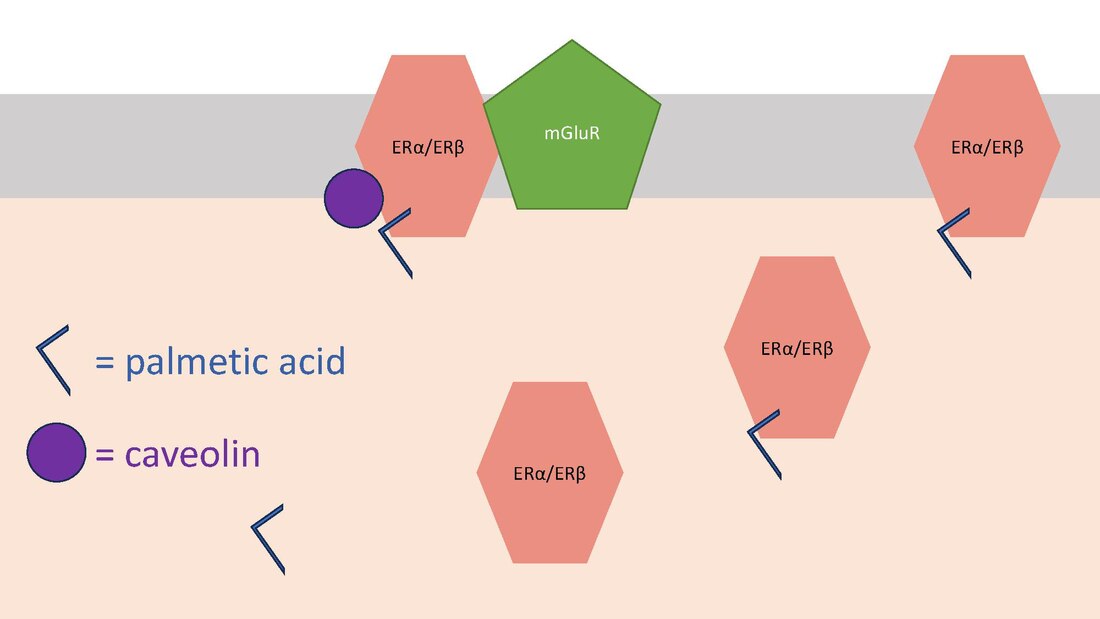Top Qs
Timeline
Chat
Perspective
Membrane estrogen receptor
From Wikipedia, the free encyclopedia
Remove ads
Membrane estrogen receptors (mERs) are a group of receptors which bind estrogen.[1][2] Unlike nuclear estrogen receptors, which mediate their effects via slower genomic mechanisms, mERs are cell surface receptors that rapidly alter cell signaling via modulation of intracellular signaling cascades.[3][4]
Nuclear estrogen receptors such as ERα and ERβ become mERs through palmitoylation, a post-translational modification that enhances ER association with caveolin-1 to enable trafficking of ERs to the membrane or membrane caveolae.[5][6] Other putative mERs include GPER (GPR30), GPRC6A, ER-X, ERx and Gq-mER.[3][7][8][9]

Remove ads
Structure-function relationship
In mice and humans, ERβ localization in the plasma membrane occurs after palmitoylation on cysteine 418.[10] Dimerization of mERs appears necessary for their function in rapid cell signaling.[11]
Signaling mechanisms
G-protein coupled receptors
Various electrophysiological studies support E2 signaling via GPCRs.[12][13][14] mERs are thought to activate G-protein coupled receptors to regulate L-type Ca2+ channels and activate protein kinase A (PKA), protein kinase C (PKC), and mitogen activated protein kinase (MAPK) signaling cascades.[15][16]
Gq-coupled mERs (Gq-mERs) activation has been demonstrated to rapidly increase membrane excitability various neuronal cell types by desensitizing GABAB receptor coupling to G protein-coupled inwardly rectifying K+ channels (GIRKs).[17][18][19]
mGluRs
Localization of mERs in caveolae allows them to be held in close proximity to specific receptors such as mGluRs.[20] Various studies have demonstrated mER's ability to activate mGluR signaling, even in the absence of glutamate.[21][22][23] ER/mGluR signaling is thought to be highly relevant for female motivational behavior. Interestingly, modification of caveolin expression appears to alter the nature of ER-mGluR interactions.[24]
Remove ads
Clinical significance
Summarize
Perspective
Membrane estrogen receptors have been implicated in reproductive, cardiovascular, neural, and immune function, including cancer, neurodegenerative disease, and cardiovascular disorders.[25][26]
Cancer
GPER1 pathways modify local inflammation and strengthen cellular immune responses in breast cancer and melanoma, making it a strong prognostic marker.[27][28][29]
Neurodegenerative disease
mERs have a demonstrated neuroprotective effect against neurodegenerative disorders like Parkinson's disease, which is thought to underlie the lower incidence of the disorder in women compared to men.[30][31]
Cardiovascular disorders
mERβ has been demonstrated to mitigate cardiac cell pathology caused by angiotensin II.[10][32] Activation of mER but not nuclear ER signaling in vascular epithelial cells promotes protection against vascular injury in mice. Striatin, a scaffolding protein that links mERs to membrane caveolae, is necessary for this effect.[33]
Addiction
Propensity to addiction appears to be mediated by sex hormones such as estrogen.[34] In neural reward circuity, nuclear ERs are not commonly expressed, and mERs have been demonstrated to act on mGluR5 to facilitate psychostimulant-induced behavioral and neurochemical effects.[35][36]
See also
References
Wikiwand - on
Seamless Wikipedia browsing. On steroids.
Remove ads
